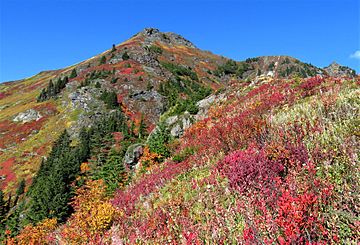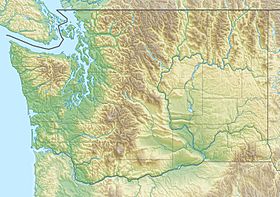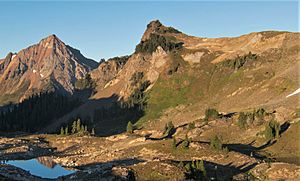Yellow Aster Butte facts for kids
Quick facts for kids Yellow Aster Butte |
|
|---|---|

Yellow Aster Butte
|
|
| Highest point | |
| Elevation | 6,241 ft (1,902 m) |
| Prominence | 681 ft (208 m) |
| Isolation | 1.77 mi (2.85 km) |
| Parent peak | Tomyhoi Peak |
| Geography | |
| Location |
|
| Parent range | North Cascades Cascade Range |
| Topo map | USGS Mount Larrabee |
| Climbing | |
| Easiest route | Hiking trail |
Yellow Aster Butte is a mountain peak in Washington state. It stands about 6,241-foot (1,902-metre) tall. This peak is located in Whatcom County, near the border with Canada.
It's part of the beautiful Mount Baker Wilderness area. The Mount Baker-Snoqualmie National Forest manages this land. Winchester Mountain is nearby, about 1.77 miles (2.85 km) to the east. Mount Larrabee is also close, about 2.3 miles (3.7 km) to the northeast. From the top, you can see amazing views. These include Mount Larrabee, Tomyhoi Peak, American Border Peak, Canadian Border Peak, Mount Shuksan, and Mount Baker.
Water flows from the mountain in different directions. Rain and snow on the north side drain into Tomyhoi Creek. The west side drains into Damfino Creek. Water from the south slope flows into Swamp Creek.
How to Visit Yellow Aster Butte
You can reach Yellow Aster Butte by hiking. The Tomyhoi Lake Trail is the main path. Its number is 686. You get to this trail from Twin Lakes Road. Twin Lakes Road is also known as Forest Service Road 3065. It branches off the Mount Baker Highway. The Yellow Aster Butte Trail (number 686.1) connects to the Tomyhoi Lake Trail. This connection is about 1.5 miles from the road.
Weather and Climate Around the Butte
Yellow Aster Butte is in a "marine west coast" climate zone. This means it's near the ocean. Most weather systems come from the Pacific Ocean. They travel northeast towards the Cascade Range.
When these weather systems hit the North Cascades, they are forced upwards. This causes them to drop a lot of rain or snow. This process is called Orographic lift. Because of this, the western side of the North Cascades gets a lot of precipitation. This is especially true in winter, when it snows a lot.
The snow here tends to be wet and heavy. This can create a high risk of avalanches. The climate is mild because it's close to the Pacific Ocean. Temperatures rarely go below 0 °F (−18 °C) or above 80 °F (27 °C).
In winter, it's often cloudy. But in summer, high pressure systems over the Pacific Ocean bring clear skies. The best time to visit or climb Yellow Aster Butte is from July to September. The weather is usually sunny then.
How the Mountains Were Formed
The North Cascades mountains have very rugged shapes. They have sharp peaks, long ridges, and deep valleys carved by glaciers. These amazing shapes were created by geological events. These events happened millions of years ago. They caused big changes in elevation. This also led to different climates across the range.
The Cascade Mountains started forming a very long time ago. This was during the late Eocene Epoch. The North American Plate was moving over the Pacific Plate. This caused many volcanic eruptions. Also, small pieces of the Earth's crust, called terranes, joined together. This helped create the North Cascades about 50 million years ago.
Over two million years ago, during the Pleistocene period, glaciers played a big role. They moved forward and backward many times. This movement carved and shaped the land. The river valleys now have a U-shape. This is a result of these recent glaciers. The rising of the land (uplift) and cracks in the Earth (faulting) also helped. These, along with glaciation, created the tall peaks and deep valleys we see today.




